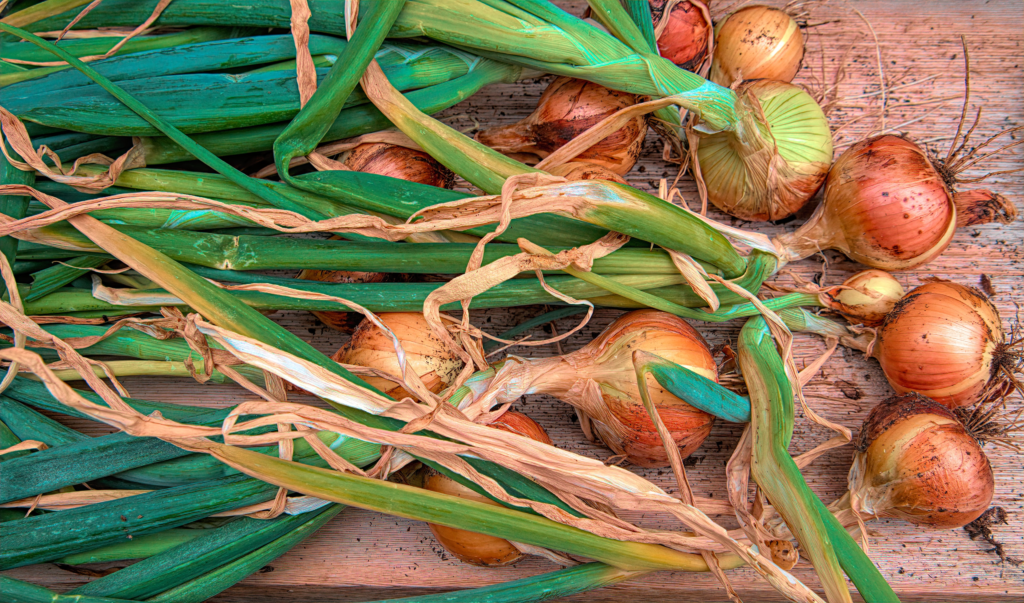
Growing onions in Florida is a task for the winter time. With so many varieties and so many culinary possibilities, this is an experiment worth digging into immediately.
| Onion | Allium cepa |
| Season (FL) | Winter |
| Soil type | Sandy loam; Fertile & well drained |
| Light | Full sun |
| Water | 1” per week |
| Mature plant size | varies |
| Harvest in | 100-130 days |
Growing onions in Florida
Look for short-day varieties, of which there are many.
Onions prefer cooler weather, and in Florida that means growing in the winter months, when the days are shorter. Conversely, onions can be planted up north in the summer, when days are longer. Thus northern gardeners would seek out long-day varieties for summer planting.
Florida onions normally begin bulbing in the short days of February or March.
Here’s a chart and map of which varieties grow best where.
Best onions for Florida: Recommended varieties
Examples of short-day varieties of onion include
- Granex types (White, Yellow, etc)
- Red Creole
- White Lisbon Bunching (green onion, spring onion, scallion)
There are plenty of other varieties available. Just make sure to obtain short day varieties.
Bunching vs bulbing onions
Put simply, bunching onions are generally immature bulbing onions. But not always, and there are exceptions.
Bunching onions Allium fistulosum
- Spring onions, green onions, welsh onions, or scallions
- May be produced from immature white (bulbing) onion varieties
Bulb onions Allium cepa (white, yellow, red)
- Long day, short day or neutral (see map)
- Bulbing is determined by day length
- Includes sweet onions – known as Vidalia in GA (a variety of sweet onion that was bred in Texas from ‘Yellow Granex’)
Leeks Allium ampeloprasum L. (porrum group)
- ‘King Richard’ is a recommended Florida variety
- Sow seeds in fall, or start as transplants
- 3 to 4 months to harvest
Shallots Allium ascalonicum
- Similar to green onions but grow in clusters of small bulbs, like garlic
- Consume the leaves and bulbs; remember to save some bulbs to plant next season
When to grow onions in Florida
Planting times vary depending on whether you’re planting seeds or transplants, so follow instructions from the vendor.
Generally, sets should be transplanted November through January. Seeds should be planted in October.
North Florida: mid-Sept – mid-Nov (seed); Nov – Jan (transplants)
Central Florida: Oct (seed); Dec – Jan (transplants)
South Florida: Oct (seed); Dec – Jan (transplants)
What you’ll need
You can buy seeds online to either direct sow in the garden, or direct sow in a tray of potting soil to later transplant into the garden.
I bought babies (sets, or small bulbs ready for transplant) from Dixondale Farms.
When browsing onion set varieties, make sure to purchase a short-day variety.
How to plant onions
A fertile, well-draining soil in a sunny location is optimal.
Plant your seeds or transplants no more than 1” deep, otherwise bulbing is inhibited.
Amend the soil in the planting area with mushroom compost, composted manure, or other medium rich in organic matter.
Transplanting onions
- Space transplants 4-6” apart. Alternatively, you could space them only 2” apart and plan on harvesting the immature onions as they grow.
- When planting leeks, plant 6” apart in holes 6” deep, without firming the soil around the plants. This dirt mounding helps create the desired ‘blanching’ effect, or white stems.
- Plant small shallot bulbs about six inches apart, leaving the growing point exposed above the surface of the ground. Harvest in early summer when the leaves turn brown.
Starting onions in trays for transplant
Grab a flat seedling tray and fill it with a couple inches of soil. Sprinkle onion seeds on top. Sprinkle in another quarter inch of soil and spray with a water bottle to keep seeds moist. Cover the tray with a clear top to retain moisture and place by the window. Seedlings should be ready for transplant in about 6 weeks. Follow the instructions above.
Growing onions in containers
Onions will grow just fine in adequately sized containers, by simply following the instructions above. Make sure they get a full day’s sunlight and that you’re using short-day varieties for your Florida container garden.
7 tips on caring for your onions
- Onions don’t mind the cold. Most onions are tolerant of temperatures as low as 20°F once roots are established.
- Thin & eat your onions if the planting bed is becoming congested.
- The shallow root system of sweet onions requires frequent watering. Discontinue watering when tops begin to fall over (signaling maturity).
- Space out plants for adequate air circulation, to prevent foliar disease.
- Weed control. Weeds will reduce crop yields.
- Mulch to retain moisture and keep weeds at bay.
- Monitor for pests and control manually before they get out of hand.
- They say you should fertilize your onions for best results.
When to harvest onions
Harvest after 4-5 months or when a quarter of the tops have fallen over. Otherwise, when tops start to turn yellow and fall over.
After harvesting, “cure” your onions in a shaded area for a couple weeks. Leave tops and roots attached. Store in a cool, dry place. Mesh bags optional.
Suggested recipes for onions
Pickled onions
Chopped into salads
Sliced into meat dishes
Leek soup
Sources
https://www.johnnyseeds.com/growers-library/vegetables/onions-leeks-production-transplants.html
https://gardeningsolutions.ifas.ufl.edu/plants/edibles/vegetables/onions-and-shallots.html
https://edis.ifas.ufl.edu/publication/MV102
https://horticulture.oregonstate.edu/oregon-vegetables/onions-green-bunching
https://www.johnnyseeds.com/growers-library/vegetables/onions/onions-key-growing-information.html
https://gardeningsolutions.ifas.ufl.edu/plants/edibles/vegetables/leeks.html